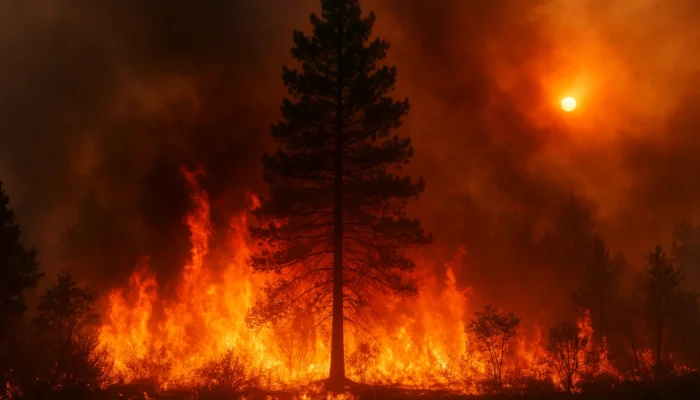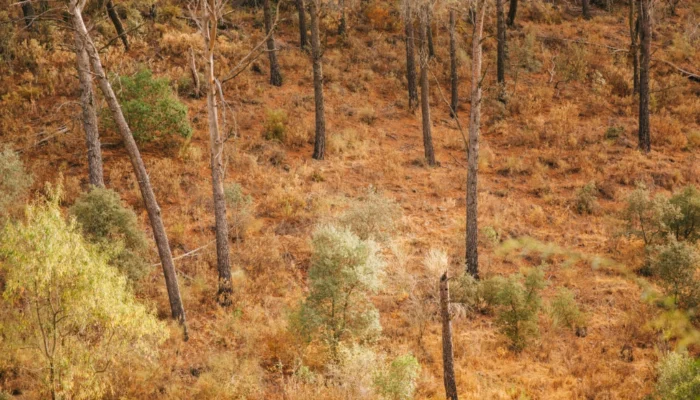Wildfires are becoming more intense and more frequent in many parts of the world, and scientists, land managers, and communities are searching for new and effective ways to protect forests and the wildlife that depends on them, and one of the most surprising discoveries is the powerful role that Beavers can play in reducing wildfire damage and slowing the spread of flames through forests that are becoming hotter and drier each year. Many people think of Beavers only as dam-building animals that reshape streams and rivers, but few realize that their natural behavior creates wetter, greener, and more resilient landscapes that are far less likely to burn, and this means Beavers may be one of the most important species to help forests adapt to climate change and the growing threat of catastrophic wildfires.
Table of Contents
ToggleThe Ecological Engineering Role of Beavers
In almost every region where they live, Beavers act as ecosystem engineers because their instinctive behaviors dramatically alter the shape, function, and water flow of the surrounding landscape, which means that their presence changes not only the physical environment but also the plant and animal communities that depend on it. When Beavers build dams out of branches, mud, stones, and vegetation, they slow the movement of water through streams and creeks, causing ponds, marshes, and wet meadows to form behind the dam, and these new wetlands attract a huge variety of birds, fish, insects, amphibians, and mammals. Over time, the repeated construction and maintenance of dams by several generations of Beavers can transform what was once a narrow and fast-moving waterway into a large and thriving wetland system rich with biodiversity and capable of holding large amounts of water even during dry seasons.
Because their dams slow down water, Beavers increase groundwater recharge, which means more water soaks into the soil where it can be stored for long periods of time, and this deep storage helps the surrounding vegetation stay moist throughout the year. By raising local water tables, keeping moisture on the land, and creating complex networks of side channels and ponds, Beavers effectively re-wet landscapes that might otherwise become dry and fire-prone, making them essential partners in building climate-resilient environments. This constant movement of water through ponds and channels also reduces soil erosion, encourages the growth of wetland plants, and stabilizes banks that might otherwise collapse during storms or spring melt, creating a more stable and balanced ecosystem overall.
.
How Beaver Wetlands Reduce Wildfire Spread

As wildfires become larger and more destructive, understanding how to slow their spread is becoming a major focus of forest management, and researchers have discovered that landscapes shaped by Beavers burn far less severely than surrounding forests without wetlands. When Beaver dams create ponds and marshes, the amount of available moisture in the ecosystem increases dramatically, and this moisture acts like a natural barrier to fire, since wet soils, wet vegetation, and standing water are far harder for flames to ignite. In many major wildfire events, satellite imagery has shown dark, burned landscapes stretching for miles, with the only green patches remaining being those around Beaver ponds, demonstrating that these animals accidentally create some of the most effective natural firebreaks in forest ecosystems.
These wetlands interrupt the continuous fuel that wildfires rely on to spread, because flames typically move most easily through areas with dry grass, brush, dead wood, and tightly packed vegetation. Beaver wetlands, however, replace these dry fuels with slow-moving water, mud, marsh grasses, and pockets of open space, all of which hinder the speed of a fire. In addition, the complex shape of a Beaver-altered waterway, full of bends, channels, and pools, forces fire to move around obstacles, which can slow it down or even stop its forward progression. In some cases, firefighters use these wetlands as staging areas or refuge zones during active fires because they are safer, cooler, and less volatile than the surrounding dry forests.
Another important factor is the way Beaver wetlands moderate temperature and humidity in their immediate area. Wetlands tend to be cooler and more humid than upland forests, and even small increases in humidity can make a significant difference in how fire behaves. Fires burn more slowly when humidity is higher, and the increased moisture near Beaver ponds can lower the intensity of flames, giving firefighters and wildlife more time to respond. This means that Beaver-modified landscapes not only resist burning but also help influence microclimates in ways that reduce the severity of fires.
.
Beaver Activity and Post-Fire Recovery
After a wildfire, landscapes that include Beaver wetlands recover faster and more completely than those without them because the wetlands act as reservoirs of life, moisture, and nutrients during and after the fire. During active fires, many animals take shelter in or near Beaver ponds, since these areas stay cooler and provide reliable access to water and food. Birds, insects, amphibians, and mammals often survive wildfires specifically because they are able to retreat to Beaver-shaped wetlands, which means that the ecosystem rebounds more quickly because a larger number of species make it through the fire.
The wet soils around Beaver ponds also promote rapid plant regrowth once the fire is over, because seeds, roots, and shoots are protected from the worst heat of the flames, and the availability of water allows plants to sprout again within days or weeks. This rapid return of vegetation stabilizes the soil, prevents erosion, and provides food and habitat for wildlife returning to the burned area. Over time, these green zones created by Beavers expand outward into burned areas, helping the entire forest recover faster than it would without the presence of wetlands.
Additionally, Beaver wetlands trap sediment, ash, and nutrients that wash down from burned slopes, keeping them from polluting downstream water bodies. This filtration process improves water quality in rivers and lakes after major fires, reducing the likelihood of harmful algal blooms and protecting drinking water supplies. Because wetlands hold water on the land, they also reduce the risk of flash floods and debris flows that are common after severe fires, protecting communities and ecosystems during the recovery period.
The Role of Beavers in Climate Change Adaptation
Climate change is altering precipitation patterns, causing longer droughts, more heatwaves, and more intense wildfire seasons, and these changes are putting tremendous stress on forests, rivers, and wildlife. In this challenging new environment, Beavers are increasingly being recognized as powerful allies in helping landscapes adapt, because their wetlands store water, cool the environment, and support biodiversity even under extreme conditions. As temperatures rise, water becomes the most important resource for maintaining healthy forests, and Beaver dams help store and distribute this water more effectively than many human-built systems.
By raising water tables and storing water in the landscape, Beavers create natural buffers against drought, allowing ecosystems to retain moisture long after streams and rivers begin to dry out. This moisture supports the growth of vegetation that can resist fire better than dry shrubs and brush, creating natural green zones that act as protective rings around forests. These wetlands also provide habitat for species that are struggling due to climate-driven changes in their environment, helping maintain biodiversity even as conditions become more difficult for many plants and animals.
Because Beaver wetlands moderate temperatures and increase humidity, they also create pockets of cooler microclimates that are less vulnerable to extreme heat events. These cool zones can serve as important refuges for wildlife during heatwaves, providing a safe and stable environment that increases survival rates. In many climate adaptation strategies, conservation biologists are encouraging the return of Beavers to areas where they were once common, because their presence strengthens entire ecosystems and increases resilience to climate-related stress.
.
Policy and Community Efforts for Beaver-Based Wildfire Mitigation
Although Beavers provide major ecological benefits, including wildfire mitigation and climate resilience, there are still challenges that communities and policymakers must address in order to fully support their return to forests where they can provide the greatest benefits. Many existing laws and regulations surrounding waterways were written at a time when Beavers were seen as pests rather than ecological allies, which means that people who want to support Beaver activity sometimes face complicated permitting processes or outdated rules that limit dam building or wetland expansion. Updating these policies is essential if communities want to encourage Beaver-based wildfire mitigation and benefit from the natural firebreaks and wet landscapes that these animals create.
Government agencies, conservation groups, and local communities are beginning to work together to introduce incentives that encourage landowners to tolerate or support Beaver activity. In some regions, landowners can receive compensation, habitat restoration assistance, or technical support for installing simple coexistence tools such as flow control devices, which allow Beavers to build dams without causing unwanted flooding. These programs help build trust between landowners and conservation professionals, showing that coexistence with Beavers is not only possible but also beneficial for the health of the entire watershed.
Community-based stewardship programs are also becoming more common, especially in areas facing repeated wildfire threats. Local watershed groups, Indigenous communities, and environmental organizations are teaching residents about the benefits of Beaver wetlands and helping monitor Beaver activity so that dams are protected and supported rather than removed. These educational efforts are crucial because many people do not realize how effective Beaver wetlands can be in reducing the damage caused by wildfires, and increasing awareness helps communities understand why supporting Beavers is a smart and cost-effective strategy.
Collaboration between fire agencies, ecologists, and local governments is another important part of developing policy frameworks that value and protect Beaver-shaped wetlands. By mapping existing Beaver ponds and identifying areas where reintroduction would create the most fire-resistant landscapes, land managers can integrate Beaver-based solutions into broader wildfire mitigation plans. This type of coordinated planning helps ensure that wetlands are protected during fire suppression activities and that future restoration efforts include opportunities for Beavers to return to areas where their natural engineering skills can make a meaningful difference.
Finally, building public awareness is essential because successful coexistence depends on people understanding the ecological importance of Beavers and the long-term benefits they bring to forests and communities. Outreach efforts that explain how Beaver dams work, how to manage potential flooding issues, and how to support safe coexistence can shift public attitudes and inspire more communities to embrace Beaver-based wildfire mitigation strategies.
.
Conclusion
Beavers are far more than simple dam-building animals; they are powerful allies in the global effort to reduce wildfire damage, restore ecosystems, and adapt to the challenges of climate change. Through their natural behaviors, they create wetlands that hold water on the landscape, slow the spread of flames, and provide essential refuges for wildlife during periods of intense heat or fire. Their wetlands help forests recover more quickly after fires, stabilize soils, improve water quality, and support a wide range of plant and animal species that rely on healthy, resilient ecosystems.
As wildfires continue to grow more severe, it is becoming increasingly clear that restoring Beaver populations is one of the most effective ways to build natural defenses against fire, because their dams and ponds create environments that resist burning and promote rapid recovery. With supportive policies, community involvement, updated management practices, and a renewed appreciation for the ecological gifts that Beavers bring to forest ecosystems, communities can take meaningful steps toward reducing wildfire risk and creating landscapes that thrive even in a warming world.




